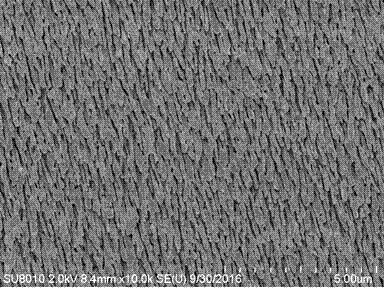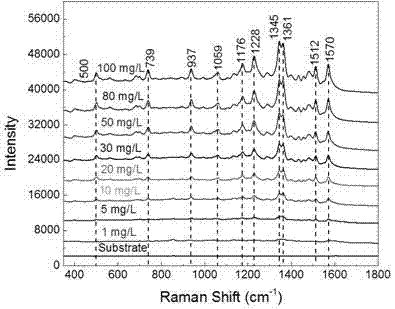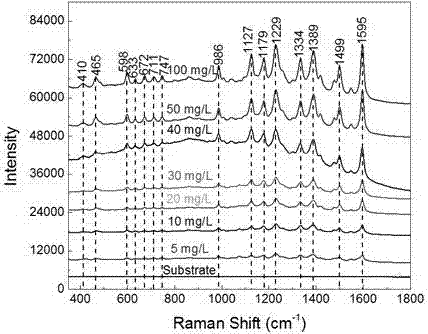Surface-enhanced Raman scattering substrate for detecting artificially synthesized pigments and preparation method and application of substrate
A technology of artificially synthesizing pigments and surface-enhanced Raman, applied in Raman scattering, measuring devices, instruments, etc., to achieve the effects of fast detection speed, low detection cost, and simple preparation process
- Summary
- Abstract
- Description
- Claims
- Application Information
AI Technical Summary
Problems solved by technology
Method used
Image
Examples
Embodiment 1
[0022] Example 1: Preparation of a surface-enhanced Raman scattering substrate.
[0023] A. Clean the substrate: first clean the substrate with a mixed solution of 98% sulfuric acid and 30% hydrogen peroxide with a volume ratio of 8:2, or deionized water and hydrogen peroxide with a volume ratio of 5:1:1 at 70°C 1. Wash the substrate with ammonium hydroxide solution for 20 minutes. Then rinse with secondary deionized water, blow dry with nitrogen, and fix in a vacuum deposition chamber;
[0024] B. Preparation of titanium and silver film layers: In order to reduce the particles in the cavity, so that the metal target can be smoothly evaporated from the bottom of the cavity to the sample stage on the upper part of the cavity, the pressure is less than 1×10 -6 In Torr’s vacuum deposition chamber, by electron beam evaporation, on the clean substrate in the previous step, a titanium thin film layer with a thickness of 20nm is deposited at a speed of 0.2nm / s, so that the silver t...
Embodiment 2
[0026] Example 2: Substrate detection of artificial synthetic pigment amaranth by surface-enhanced Raman scattering.
[0027] At room temperature, take 2 μL of artificial synthetic pigment amaranth solution with different concentrations (1mg / L, 5mg / L, 10mg / L, 20mg / L, 30mg / L, 50mg / L, 80mg / L, 100mg / L) Drop onto the surface of the substrate. After being naturally air-dried, any 9 positions of each sample on the substrate were selected and detected by a Raman spectrometer. The detection condition is that the laser power of the spectrometer is 100mW, and the scanning time is 1s. Spectral detection range 350-1800cm -1 , and the detection result is the average spectrum of 9 sample points.
[0028] Such as figure 2 As shown, the minimum concentration of amaranth solution detected by this substrate is 1mg / L, which can be used as the detection limit of amaranth.
Embodiment 3
[0029] Example 3: Substrate Detection of Surface Enhanced Raman Scattering Artificial Synthetic Pigment Sunset Yellow.
[0030]Take 2μL of artificial synthetic pigment sunset yellow aqueous solution with different concentrations (1mg / L, 5mg / L, 10mg / L, 20mg / L, 30mg / L, 50mg / L, 80mg / L, 100mg / L) dropwise on the surface of the substrate . After being naturally air-dried, any 9 positions of each sample on the substrate were selected and detected by a Raman spectrometer. The detection condition is that the laser power of the spectrometer is 100mW, and the scanning time is 10s. Spectral detection range 350-1800cm -1 , and the detection result is the average spectrum of 9 sample points.
[0031] Such as image 3 As shown, the minimum concentration of sunset yellow solution detected by this substrate is 5mg / L, which can be used as the detection limit of sunset yellow.
[0032] In addition, the concentration of other artificial pigments such as tartrazine, indigo, and brilliant blue...
PUM
| Property | Measurement | Unit |
|---|---|---|
| length | aaaaa | aaaaa |
| diameter | aaaaa | aaaaa |
| thickness | aaaaa | aaaaa |
Abstract
Description
Claims
Application Information
 Login to View More
Login to View More - R&D
- Intellectual Property
- Life Sciences
- Materials
- Tech Scout
- Unparalleled Data Quality
- Higher Quality Content
- 60% Fewer Hallucinations
Browse by: Latest US Patents, China's latest patents, Technical Efficacy Thesaurus, Application Domain, Technology Topic, Popular Technical Reports.
© 2025 PatSnap. All rights reserved.Legal|Privacy policy|Modern Slavery Act Transparency Statement|Sitemap|About US| Contact US: help@patsnap.com



